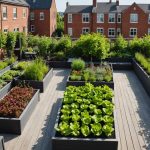Starting a compost bin at home is an excellent way to reduce your waste, enrich your garden soil, and contribute positively to the environment. Composting transforms your scraps—such as food leftovers and yard debris—into a nutrient-rich material that supports healthy plant growth. In this guide, we will explore the composting process, what materials you can add, and how to effectively manage your compost bin or pile to optimize results.
Understanding the Composting Process
Composting is a natural process that breaks down organic materials into a rich soil amendment. To start, you need to gather both green and brown materials. Green materials are rich in nitrogen and include items like fruit and vegetable scraps, coffee grounds, and grass clippings. On the other hand, brown materials are high in carbon and include leaves, straw, and shredded paper.
Also read : How do I create a vertical garden in a small outdoor area?
When you combine these materials in a bin or pile, microorganisms begin to break down the organic matter. This decomposition process is aided by moisture and air. Therefore, it’s essential to maintain a balance of these elements. If the compost pile is too wet, it may become anaerobic, leading to unpleasant odors. If it’s too dry, the decomposition process will slow down significantly.
To start your compost bin, you should select a suitable location—preferably a well-drained area that receives some sunlight. You can purchase a pre-made bin or create one from wood pallets or wire mesh. The size of your compost bin can vary, but a three-foot by three-foot area is generally considered effective.
Also read : What are the best companion plants for tomatoes to improve growth and flavor?
Layering your materials is also crucial. Start with a base of coarse brown materials to improve airflow. Then alternate layers of green and brown materials, ensuring that you maintain a ratio of approximately 2:1 of brown to green. This will foster an ideal environment for microorganisms to thrive and speed up the composting process.
What Materials Can You Add to Your Compost Bin?
When starting a compost bin, knowing what to include is vital for creating effective compost. You can add a wide variety of materials; however, it’s important to differentiate between suitable and unsuitable items.
Suitable items include:
- Food Scraps: Vegetable peels, fruit cores, and leftover grains are excellent sources of nitrogen.
- Coffee Grounds: These add a good amount of nitrogen and improve the acidity of the compost.
- Grass Clippings: Freshly mowed grass provides both nitrogen and moisture.
- Eggshells: These add calcium to your compost and help improve soil structure.
- Yard Waste: Leaves, small branches, and plant trimmings contribute to the brown material.
Avoid adding:
- Meat, Dairy, and Oils: These can attract pests and create foul odors.
- Processed Foods: These often contain preservatives that can inhibit the composting process.
- Weeds with Seeds: Adding these can result in unwanted growth in your garden when you use the compost.
- Dog or Cat Waste: These can introduce pathogens harmful to humans and plants.
Each layer of green and brown materials should be mixed in your bin. This helps to aerate the pile, allowing oxygen to reach the microorganisms essential for decomposition. Remember that the smaller the pieces of material, the faster they will break down. So, consider chopping or shredding larger items before adding them to your compost pile.
Managing Your Compost Bin for Optimal Results
Managing your compost bin effectively ensures that the process is efficient and provides high-quality compost. One key aspect is maintaining the right moisture level. Your compost should feel like a damp sponge—moist but not dripping wet. If you find your compost is too dry, you can add water or additional green materials, while too much moisture can be balanced out by incorporating more brown materials.
Aeration is another essential factor in successful composting. To promote airflow, turn your pile with a pitchfork or shovel every few weeks. This helps to break up compacted layers and allows oxygen to circulate. Without sufficient aeration, the microorganisms may die off, leading to a slower decomposition process.
Temperature is also an indicator of how well your compost bin is performing. A hot compost pile can reach temperatures of 130°F to 160°F. This heat is generated by the activity of microorganisms breaking down the organic materials. If your pile is not heating up, it may be due to a lack of moisture, insufficient nitrogen materials, or poor aeration. If you notice it becoming too hot, you can cool it down by adding more brown materials.
Lastly, patience is crucial in the composting journey. Depending on various factors like the materials used, the size of the pile, and the environmental conditions, it can take anywhere from a few weeks to several months for your compost to mature. When finished, the compost should resemble dark, crumbly soil and have an earthy smell. Use it to enrich your garden beds, improve soil health, and support your plants.
Benefits of Composting at Home
Composting at home offers numerous benefits that extend beyond enriching your garden soil. Firstly, it significantly reduces the amount of waste sent to landfills. By diverting food scraps and yard debris from the trash, you contribute to a more sustainable waste management practice.
In addition to reducing waste, composting enhances soil quality. The resulting compost is rich in nutrients, which provide essential elements for plant growth. It also improves soil structure, aiding in moisture retention and aeration. This is particularly beneficial for maintaining healthy plants in your garden and can even help reduce the need for chemical fertilizers.
Moreover, composting fosters a thriving ecosystem in your yard. Compost attracts beneficial insects and microorganisms that contribute to a healthy garden environment. This biodiverse community helps control pests naturally and promotes the growth of robust plants.
Financially, composting can also lead to savings. By producing your own compost, you can minimize the need to purchase store-bought fertilizers and soil amendments. Furthermore, many municipalities offer discounts or incentives for residents who practice composting, contributing to a more eco-friendly community.
Lastly, composting educates you about the organic materials in your kitchen and how they can be reused. This awareness promotes sustainable practices, helping to cultivate a more environmentally-conscious mindset. In essence, by starting a compost bin at home, you are taking an active role in environmental stewardship while benefiting your garden and wallet.
Starting a compost bin at home is a straightforward yet impactful way to contribute to a sustainable environment. By understanding the composting process, knowing what materials to include, managing your bin effectively, and recognizing the benefits, you can create a rewarding cycle of waste reduction and soil enrichment. Embrace the journey of composting, and enjoy the fruits of your labor in a thriving garden.











